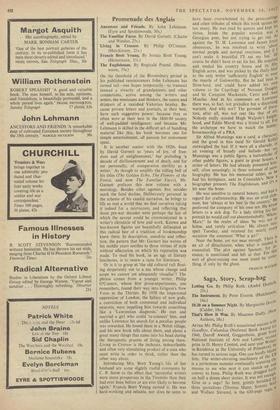Promenade des Anglais
Ancestors and Friends. By John Lehmann. (Eyre and Spottiswoode, 30s.) ON the threshold of the Bloomsbury period in his published reminiscences John Lehmann has
turned tail—one hopes temporarily—to transmit instead a vivacity of grandparents and other connections, active among the writers and artists, the musicians and thinkers, the eaters and drinkers of a vanished Victorian heyday. Be- cause private letters and journals, at their best, have such suggestive power; because they so often were at their best in the 1860-90 society of well-padded intelligence; and because Mr. Lehmann is skilled in the difficult art of handling material like this, his book becomes one for simple entertainment, all passion for assessment spent.
It is another matter with the 1920s fixed by David Garnett as 'years of joy, of free- dom and of enlightenment,' but preluding 'a decade of disillusionment and of death, and for me personally, of comparative sterility as a writer.' As though to amplify the tolling bell of his titles (The Golden Echo, The Flowers of the Forest, and now The Familiar Faces), Mr. Garnett prefaces this new volume with a necrology. Besides other agonies, five suicides mark the fatal decline. Deliberately personal in the scheme of his candid narration, he brings to life so real a world that we find ourselves taking it indeed for a microcosm, and reflecting that those pre-war decades were perhaps the last of which the savour could be communicated in a writer's chronicle of love and work. Known and less-known figures are beautifully delineated as this radical heir of a tradition of bookmanship knew them. In description, anecdote and reflec- tion, the pattern that Mr. Garnett has woven of his middle years testifies to those virtues of style without affectation on which his reputation was made. To read his book, in an age of literary luncheons, is to renew a taste for literature.
Or is it to grasp at 'the old cultural raft float- ing desperately out to a sea whose change and scope we cannot yet adequately visualise'? The phrase comes from a younger writer, Philip O'Connor, whose first prose-experiments, one remembers, found their way into Grigson's New Verse in the Thirties. By 1958 the impersonal oppression of London, the failure of new gods, a conviction of both communal and individual neurosis, were impelling him towards something like a `Lawrentian diagnosis.' He met and married a girl who could 're-connect' him, and unlike Lawrence his search for a peculiar people was rewarded. He found them in a Welsh village, and his new book tells about them, and about a great many things that came into his head during the therapeutic process of living among them. Living in Croesor is the inchoate, indescribable and often very stimulating product of a man who must write in order to think, rather than the other way about.
Introducing Mrs. Brett Young's life of her husband are some slightly rueful comments by C. P. Snow to the effect that 'successful writers were more prosperous in the Twenties than they had ever been before or are ever likely to become again.' Francis Brett Young earned it. He was hard-working and reliable, nor does he seem to have been overwhelmed by the press-cuttings and other tributes of which this book quotes far too many. He was read by queens and kept his virtue. Inside the popular novelist was A3 Georgian poet, but not trying to get out. As against the 'D. H. Lawrence and James Joyce obsessions,' he was resolved to write 'about normal people and normal reactions, and if can't make it beautiful I'll eat my hat.' of course he didn't have to eat his hat. He acquired and tended his country house and its fifty English acres, and was picked by the Daily Mail as the only writer 'sufficiently English' to wear the mantle of Galsworthy. But he had been to Siren-land, and could have added his own volume to the Caprilogy of Norman Douglas, and Sir Compton Mackenzie, Cerio and Mel Munthe. And in his comments on Lawrence there was, in fact, not prejudice but a discerning warmth. And why not? The garment of liters' ture, after all, was not rent like that of art' Nobody really minded Hugh Walpole's knight' hood, and Eddie Marsh was a friend to all For the archetype we have to watch the hobby' horsemanship of a PRA. Sir Alfred Munnings was a card, a character, and the good in him (said Sir Gerald Kelly) outweighed the bad. If it were all a charade, or an evening of brandy and ballads—but o°,: Munnings was a public figure, a buttonholer or other public figures, a guest in great houses, 3 writer of letters. He had already presented hint' self, often amusingly, in three volumes of auto- biography. He has his memorial tablet, as be had his birthplace, next to Constable's. Now a biographer presents The Englishman, and It's 3 bit near the bone. He was sensitive to natural beauty, and had ,a. regard for craftsmanship. He was an avid man, but 'always at his best in the country. 1-1,,` preferred the company of his own sex. He wrote letters to a sick dog. To a lady sitting fur,he, portrait he would call out absentmindedly,14W–t Mare!' In the realm of ideas 'he was not 3 hotne, and rarely articulate.' He always Os'
everY spelt Tuesday, and retained for nearly occasion the comment 'What a go!' h re is
Near the bone, yet not near enough. is an air of detachment, when what is needed, committal. The plot against Spencer, for ,n_'is stance, is mentioned and left at that. For ta sort of ghost-raising one must stand by s°111e. thing, if only by the ghost. ..„.TSON v,
FRANCIS •






































 Previous page
Previous page